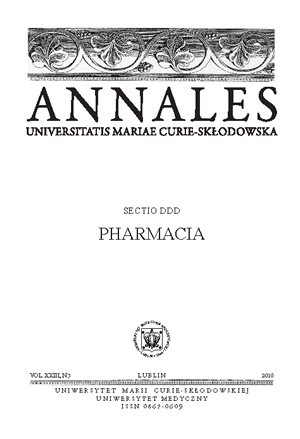Islet GAD autoantibodies in patients with newly diagnosed type 2 diabetes
Keywords:
GAD autoantibody, newly diagnosed type 2 diabetes, latent autoimmunologic diabetes of adults (LADA)Abstract
Introduction. Autoagression against islet cells is characterized by a presence of anti‑insulin antibodies and anti-glutamic acid decarboxylase antibodies (GADA), as well as other autoantigens. The marker with the highest diagnostic value in adults is GADA which helps diagnose the so-called latent autoimmune diabetes in adults (LADA).
Aim of the study. To establish the prevalence and concentrations of GADA in groups of patients with newly diagnosed type 2 diabetes.
Material. 48 (26F; 22M) patients aged from 34 to 74, mean 54.8±10.4 years.
Methods. Diabetes was diagnosed according to the standards set by the Polish Diabetes Association. GADA was determined by radioimmunologic assay using the GAD-AB kit with CIS reagents. A level over 1U/ml was accepted as positive.
Results. The presence of GADA at concentration >1U/ml was found in 20 (41.7%) [12F; 8M]. In this group high titers characterized only 2 men (4.2% of the whole group and 10% of patients with positive GADA) and they were 16.8 and 64.5 U/ml, respectively. In the remaining 18 pateints [37.5%] (11F; 7M), GADA concentrations were only slightly elevated and they were between 1.01 and 2.0 U/ml (mean 1.21±0.2 U/ml). In 13 patients (27.1%) [8F; 5M] GADA levels were between 0.3 and 1.0 U/ml (mean 0.74±0.23). In the remaining 15 patients (31.2%) [7F; 8M] GAD antibodies were not found.
Conclusions. In the majority of patients with newly diagnosed type 2 diabetes anti-glutamic acid decarboxylase antibodies were found in low titers.
References
1. Appel S. J., Wadas T. M., Rosenthal R. S. et al. Latent autoimmune diabetes of adulthood (LADA): an often misdiagnosed type of diabetes mellitus. J Am Acad Nurse Pract. 21(3):156; 2009.
2. Bingley P. J. Clinical applications of diabetes antibody testing. J Clin Endocrinol Metab. 95: 25; 2010.
3. Buzzetti R., Di Pietro S., Giaccari A. et al. Non Insulin Requiring Autoimmune Diabetes Study Group. High titer of autoantibodies to GAD identifies a specific phenotype of adult-onset autoimmune diabetes. Diabetes Care. 30 (4): 932; 2007.
4. van Deutekom A. W., Heine R. J., Simsek S. The islet autoantibody titres: their clinical relevance in latent autoimmune diabetes in adults (LADA) and the classification of diabetes mellitus. Diabet Med. 25(2):117; 2008.
5. Falorni A, Brozzetti A. Diabetes-related antibodies in adult diabetic patients. Best Pract Res Clin Endocrinol Metab. 19(1): 119; 2005.
6. Isermann B., Ritzel R., Zorn M. et al. Autoantibodies in diabetes mellitus: current utility and perspectives. Exp Clin Endocrinol Diabetes. 115(8): 483; 2007.
7. Lohmann T., Kellner K., Verlohren H. J. et al. Titre and combination of ICA and autoantibodies to glutamic acid decarboxylase discriminate two clinically distinct types of latent autoimmune diabetes in adults (LADA). Diabetologia 44(8): 1005 ; 2001.
8. Naik R. G., Brooks-Worrell B. M., Palmer J. P. Latent autoimmune diabetes in adults. J Clin Endocrinol Metab. 94(12): 4635; 2009.
9. Pihoker C., Gilliam L. K., Hampe C.S. et al. Autoantibodies in diabetes. Diabetes 54 (Suppl. 2):S52; 2005.
10. Radtke M. A., Midthjell K., Nilsen T.I. et al.. Heterogeneity of patients with latent autoimmune diabetes in adults: linkage to autoimmunity is apparent only in those with perceived need for insulin treatment: results from the Nord-Trøndelag Health (HUNT) study. Diabetes Care. 32(2): 245; 2009.
11. Rosário P. W., Reis J. S., Fagundes T. A. et al. Latent autoimmune diabetes in adults (LADA): usefulness of anti-GAD antibody titers and benefit of early insulinization. Arq Bras Endocrinol Metabol. 51(1): 52; 2007.
12. Schranz D. B., Bekris L., Landin-Olsson M. et al.: Newly diagnosed latent autoimmune diabetes in adults (LADA) is associated with low level glutamate decarboxylase (GAD65) and IA-2 autoantibodies. Diabetes Incidence Study in Sweden (DISS). Horm. Metab. Res. 32(4), 133; 2000.
13. Seissler J., Scherbaum W. A. Autoimmune diagnostics in diabetes mellitus. Clin Chem Lab Med 44(2): 133; 2006.
14. Syed M.A., Barinas-Mitchell E., Pietropaolo S. L. et al. Is type 2 diabetes a chronic inflammatory/autoimmune disease? Diabetes Nutr Metab. 15(2): 68; 2002.
15. Carlsson S., Midthjell K., Tesfamarian M. Y. et al: Age, overweight and physical inactivity increase the risk of latent autoimmune diabetes in adults: results from the Nord-Trøndelag Health Study. Diabetologia 50(1): 55; 2007.
Downloads
Published
Issue
Section
License
Copyright (c) 2025 Authors

This work is licensed under a Creative Commons Attribution-NonCommercial-NoDerivatives 3.0 Unported License.


